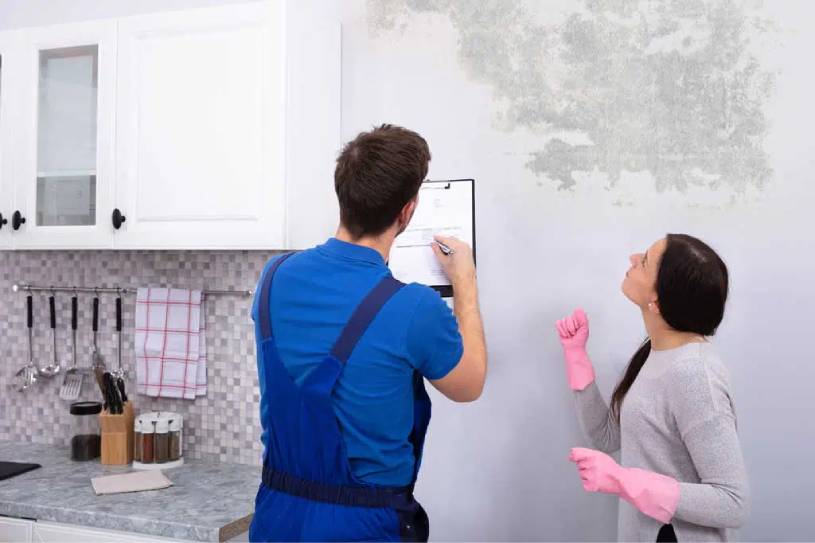Homeownership comes with its joys, but it also brings the responsibility of maintaining a safe and healthy living environment. One crucial aspect of this is ensuring your home is free from mold, a potential threat that can affect your home’s structure and your family’s well-being.
Understanding the Role of Home Inspection Services
Home inspection services play a vital role in identifying potential issues within your home, including the presence of mold. These services are designed to thoroughly examine various aspects of your home, ensuring that it meets safety standards and is free from any hidden problems.
The Importance of Mold Inspection
Among the many concerns home inspection services address, mold inspection is a key component. Mold, a type of fungus that thrives in damp and humid conditions, can go unnoticed for a long time, causing structural damage and posing health risks. Mold inspection is the first step in identifying and addressing these issues before they escalate.
Table of Contents
What Happens During a Mold Inspection?
So, you’ve scheduled a mold inspection – what can you expect during this crucial process? Let’s break down the key components to help you understand the ins and outs of a mold inspection.
1. Initial Assessment: Setting the Stage
The mold inspection process typically begins with a comprehensive assessment of your property. Experienced professionals will examine the exterior and interior of your home, seeking signs of water damage, leaks, or any conditions conducive to mold growth.
2. Indoor Air Quality Testing: A Closer Look
One of the primary focuses of mold inspection is testing the indoor air quality. Specialized equipment is used to collect air samples from various areas in your home. These samples are then analyzed to identify the presence and concentration of mold spores.
3. Surface Sampling: Pinpointing Mold Growth
In addition to air quality testing, inspectors may take surface samples from areas suspected of mold growth. These samples provide more detailed information about the types of mold present and help determine the infestation’s severity.
4. Moisture Detection: Unveiling Hidden Issues
Mold thrives in damp environments, so detecting moisture sources is a crucial aspect of the inspection. Professionals use moisture meters and thermal imaging to identify hidden water leaks or areas with elevated humidity levels.
5. Visual Inspection: The Eyes Never Lie
A thorough visual inspection is a fundamental part of the process. Inspectors will examine walls, ceilings, floors, and other surfaces for visible signs of mold, such as discoloration, staining, or the distinctive musty odor associated with mold growth.
6. Documentation: Recording the Findings
Throughout the inspection, inspectors document their findings, noting areas of concern, moisture issues, and types of mold identified. This documentation serves as a basis for creating a comprehensive report that will be shared with you.
Now that you understand what happens during a mold inspection better, stay with us as we move on to the critical next steps in the recovery process – finding the right professionals and decoding the results.
Finding the Right Mold Inspector
Now that you’ve undergone a mold inspection, the next crucial step is finding the right professionals to guide you through recovery. Let’s explore how to identify the best mold inspectors in your area.
1. Understanding the Significance of Choosing the Best
Selecting the right mold inspector is paramount to ensuring an accurate assessment and effective remediation. Experienced professionals bring expertise, precision, and the necessary tools to address mold issues comprehensively.
2. Online Resources: Your First Port of Call
The internet is a valuable resource for finding reputable mold inspectors. Conduct a search using relevant keywords like “best mold inspectors near me” to generate a list of potential candidates. Reviewing customer testimonials and ratings can provide insights into the quality of their services.
3. Local Options: The Convenience Factor
Consider local options when searching for mold inspectors. Local professionals are often more familiar with regional environmental conditions and can respond promptly to your needs. Utilize online directories, community forums, or recommendations from neighbors to identify qualified inspectors nearby.
4. Credentials Matter: Look for Certification
Ensure that the mold inspectors you’re considering hold relevant certifications. Certifications from recognized organizations, such as the National Environmental Health Association (NEHA) or the Indoor Air Quality Association (IAQA), indicate a commitment to professional standards and ongoing education.
5. Licensing and Insurance: Protecting Your Interests
Check if the mold inspectors are licensed and insured. Licensing requirements vary by state, so familiarize yourself with the regulations in your area. Insurance provides protection for both you and the inspectors in case of unexpected issues during the inspection or remediation process.
6. Requesting Quotes: Understanding the Costs
Contact multiple mold inspectors to request quotes for their services. A comprehensive quote should outline the scope of the inspection, testing procedures, and any additional services offered. Be wary of excessively low prices, as they may indicate a lack of expertise or thoroughness.

7. Personal Recommendations: Trusting Your Network
Word of mouth can be a powerful tool in finding reliable mold inspectors. Seek recommendations from friends, family, or colleagues who have undergone similar processes. Personal experiences can provide valuable insights into the inspector’s professionalism and the effectiveness of their services.
8. Comparing Services: Making an Informed Decision
Once you’ve gathered information from various inspectors, compare their services, pricing, and customer reviews. Consider the overall value they provide, balancing expertise and cost-effectiveness. Making an informed decision ensures you choose a professional who meets your specific needs.
Decoding Mold Testing: Understanding the Results
Now that you’ve enlisted the help of a qualified mold inspector, it’s time to delve into the crucial process of mold testing. Let’s explore what mold testing entails and how you can decipher the results.
1. Differentiating Between Mold Inspection and Mold Testing
Before we dive into the specifics of mold testing, it’s essential to understand the distinction between mold inspection and mold testing. While inspection involves a visual assessment and identification of potential issues, testing goes a step further by analyzing samples to determine the type and concentration of mold present.
2. Why Mold Testing Is Crucial
Mold testing is a critical component of the overall assessment process. It provides a detailed analysis of the air and surfaces within your home, helping to identify the extent of mold contamination. The results guide the development of an effective remediation plan tailored to your specific situation.
3. Locating Professionals for “Mold Testing Near Me”
If you haven’t already undergone mold testing or if you’re considering a separate testing service, it’s essential to find professionals specializing in mold testing. Utilize online searches with keywords like “mold testing near me” to identify qualified experts in your area.
4. Types of Mold Tests: Exploring Your Options
There are various types of mold tests, each serving a specific purpose. Common tests include air sampling, surface sampling, and bulk sampling. Your mold inspector will determine the most appropriate tests based on the suspected contamination areas and the inspection goals.
5. Interpreting Air Quality Test Results
Air sampling is a prevalent method for mold testing. The results provide information about the concentration and types of mold spores present in the air. Interpreting these results requires expertise, and your mold inspector will guide you through understanding the significance of the findings.
6. Surface Sampling: Identifying Mold on Surfaces
Surface sampling involves collecting samples from suspected mold growth areas. These samples help identify the specific types of mold present on surfaces. Understanding surface test results is crucial for planning targeted remediation efforts.
7. Bulk Sampling: Assessing Material Contamination
Bulk sampling entails collecting physical samples of materials suspected of harboring mold, such as drywall or insulation. The analysis of these samples provides insights into the extent of mold contamination within building materials.
8. Comprehensive Reporting: A Guide for Action
After conducting mold testing, your inspector will compile the results into a comprehensive report. This report outlines the types of mold identified, their concentrations, and recommendations for remediation. Understanding this report is crucial for taking informed action.
The Results Are In: Now What?
Congratulations, you’ve completed the mold inspection and testing phases. Now, it’s time to understand the results and take decisive steps to ensure a mold-free home. Let’s explore the key actions to take after receiving your mold inspection and testing reports.
1. Interpreting Mold Inspection and Testing Results
Your mold inspection and testing report will provide detailed information about the types of mold present, their concentrations, and the areas affected. Work closely with your inspector to interpret these results, gaining a clear understanding of the severity of the mold issue.
2. Common Types of Mold: Identifying the Culprits
The report will likely identify specific types of mold present in your home. Common molds include Aspergillus, Penicillium, and Stachybotrys (black mold). Understanding these molds and their potential health effects is crucial for informed decision-making.
3. Potential Health Risks: What You Need to Know
Certain molds can pose health risks, especially to individuals with allergies, respiratory conditions, or compromised immune systems. Consult with your healthcare professional if you have concerns about the potential health effects of mold exposure identified in the report.
4. Immediate Mold Remediation Steps
Upon understanding the results, initiate immediate remediation steps to address the identified mold issues. Work with professionals experienced in mold removal to ensure a thorough and effective remediation process.
5. Collaborating with Professionals: Mold Removal Experts
Engage the services of mold removal experts who specialize in safe and effective remediation. Professionals will follow industry best practices, utilizing proper protective gear, containment procedures, and environmentally friendly cleaning agents.
6. Addressing Underlying Issues: Prevention for the Future
To prevent future mold issues, address the underlying causes identified during the inspection. This may involve fixing leaks, improving ventilation, and addressing moisture-related concerns. A holistic approach ensures a long-term solution.
7. Regular Home Inspections: Staying Proactive
Implement a schedule for regular home inspections to catch potential issues early on. Periodic inspections, especially in areas prone to moisture, can help prevent the recurrence of mold problems and maintain a healthy living environment.
8. Educating Homeowners: Empowering Prevention
Empower yourself and fellow homeowners by sharing knowledge about mold prevention. Educate your community about the importance of regular inspections, prompt remediation, and maintaining a healthy home environment.












53 Responses
Hi! Do you know if they make any plugins to help with SEO?
I’m trying to get my blog to rank for some targeted keywords but I’m not seeing
very good success. If you know of any please share.
Thanks! I saw similar blog here: Wool product
sugar defender official website I have actually dealt with
blood sugar variations for many years, and it actually impacted my
energy degrees throughout the day. Considering that beginning Sugar Defender,
I feel a lot more balanced and sharp, and I don’t
experience those mid-day sags any longer! I enjoy that it’s
an all-natural remedy that functions without any rough negative effects.
It’s truly been a game-changer for me
herpafend-try.com Herpafend is a dietary supplement
designed to reduce herpes symptoms. It boosts the immune system and reduces
the frequency of outbreaks. Formulated with ingredients like elderberry, echinacea,
and L-lysine compound, Herpafend promotes wellness.
Manufactured in the USA in an FDA-registered facility, Herpafend guarantees top quality.
It is non-GMO and free of gluten. Customers say a reduction in outbreak frequency and
severity.
Try Herpafend today and see the difference in your symptom control.
All driving instructor applicants will need to pay for a three-year authority, as per
the current Road Safety (Driving Instructors) Regulations 2020.
Do something you love and you’ll never have to work a day in your life.
Imagine that you do two-hour lessons from 0930 to 1130, 1300 to 1500 and 1700 to 1900.
And last, but certainly not least, the superb support we get from the
developers.
Our best recommendation when it comes to driving as a beginner is to start
with a driver’s ed course, which will help you
go over all of the basic lessons.
For queries or advice about employment rights, contact the Labour Relations Agency.
Interested in meeting new people and playing a part
in their driving success?
Discover many more happy student success stories on our Facebook page.
New ADI test times pop up at random whenever they feel like
it.
Pay attention to their communication skills, patience, and ability to explain concepts clearly.
We are proud to work with a collection of companies that offer
the best services to driving instructors.
Combine that with taking weekly driving lessons
with an instructor and you’ll be a pro in no time.
It can feel like you’re a naughty kid at first, bunking off
school and spending time at home.
It’s easy to use and has so many additional benefits rolled
into a very reasonable monthly fee.
You pay the school a set weekly/monthly amount to be given a car and supplied
with work.
Whether you’re restoring, waxing or washing your
vehicle, our friends at Turtle Wax have got
you covered.
It’s your policy so it affects you – even though you’re the only
one that did nothing wrong!
The most common catch is that they make you sign a contract where you agree to pay
their franchise fee for 6 to 24 months.
Another great rule to remember is that more speed is equal to less control,
so when in doubt it’s always better to slow down a bit than to accelerate.
Track the performance of instructors on pass rates, cancellations and every
pupils driving progress.
Consider there is usually a 3 to 6-month waiting time for ADI part 2 and ADI part 3 tests.
Practice makes perfect, and will be the best way for you to get comfortable behind the wheel and calm your nerves.
He is qualified to teach in manual transmission cars and
heavy goods.
There’s a lot of downtime and I have known some people struggle with this.
Customise the app, by adding your driving school name,
logo and company colours to brand the pupil app as your driving school.
It’ll cost around £2,500 but remember it’s different for everyone.
This isn’t such a big issue but people have cited it as a reason for not starting lessons.
You can go home, go for a walk or do whatever you want to do.
Having used one of Total Drives major competitors
previously, I was convinced that they could not be beaten.
Requirements to become a certified instructor for a licensed driving school.
5-hour course online at a convenient time, with certificate delivery available.
Their road trip provides an epiphany for Ben, who has his first sexual experience with Bryony, one of the young women organizing the event.
We provide the highest-quality driver training and education to both
teen and adult drivers.
What’s up every one, here every one is sharing these knowledge,
thus it’s pleasant to read this webpage, and I used to visit this web site
everyday.
Hello there! Do you know if they make any plugins to assist
with SEO? I’m trying to get my blog to rank for some targeted keywords but I’m not seeing very good
gains. If you know of any please share. Cheers! I saw similar text
here: Change your life
You actually make it appear really easy together with your
presentation but I in finding this matter to be actually something that I believe I’d by
no means understand. It kind of feels too complicated
and extremely broad for me. I am taking a look ahead to your next post, I will try to get the grasp
of it!
25 Fun Issues To Do In Orange County At Night For 2025
다낭밤문화 (https://Hivnmsite.com)
Your point of view caught my eye and was very interesting. Thanks. I have a question for you.
The colleges of tourism administration eye on the areas of event and lodge operations, as well as gaming and restaurant operations.
Around the same time as Katyn, greater than 15,000 other Polish POWs are killed at different places.
The movie screens found in most fashionable commercial theaters also reap the benefits of this material because it permits for top brilliance below dark circumstances.
Your article helped me a lot, is there any more related content? Thanks!
I’m extremely inspired together with your writing talents and also with the format in your weblog. Is this a paid theme or did you customize it your self? Anyway stay up the excellent quality writing, it’s uncommon to see a great weblog like this one nowadays. I like ethosglobe.com ! Mine is: Stan Store
I am really impressed with your writing skills as neatly as with the layout in your weblog. Is this a paid theme or did you customize it your self? Either way keep up the excellent quality writing, it’s uncommon to look a great blog like this one nowadays. I like ethosglobe.com ! It’s my: Snipfeed
Very informative!
Solid advice, thanks!
So true, thanks!
Such a useful guide.
Really appreciate your effort.
Thanks for simplifying it.